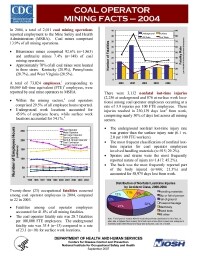Mining Publication: Coal Operator Mining Facts - 2004
Original creation date: September 2007
Authors: National Institute for Occupational Safety and Health
NIOSHTIC2 Number: 20032733
Pittsburgh, PA: U.S. Department of Health and Human Services, Public Health Service, Centers for Disease Control and Prevention, National Institute for Occupational Safety and Health, DHHS (NIOSH) Publication No. 2007-167, 2007 Sep; :1-2
In 2004, a total of 2,011 coal mining operations reported employment to the Mine Safety and Health Administration (MSHA). Coal mines comprised 13.9% of all mining operations. Bituminous mines comprised 92.6% (n=1,863) and anthracite mines 7.4% (n=148) of coal mining operations. Approximately 70% of all coal mines were located in three states: Kentucky (28.9%), Pennsylvania (20.7%), and West Virginia (20.5%). A total of 73,024 employees, corresponding to 80,069 full-time equivalent (FTE) employees, were reported by coal mine operators to MSHA. Within the mining sectors, coal operators comprised 29.5% of all employee hours reported. Underground work locations accounted for 45.9% of employee hours, while surface work locations accounted for 54.1%. Twenty-three (23) occupational fatalities occurred among coal operator employees in 2004, compared to 22 in 2003. Fatalities among coal operator employees accounted for 41.8% of all mining fatalities. The coal operator fatality rate was 28.7 fatalities per 100,000 FTE employees. The underground fatality rate was 35.4 (n=13) compared to a rate of 23.1 (n=10) for surface work locations. There were 3,132 nonfatal lost-time injuries (2,256 at underground and 876 at surface work locations) among coal operator employees occurring at a rate of 3.9 injuries per 100 FTE employees. These injuries resulted in 230,139 days lost from work, comprising nearly 50% of days lost across all mining sectors. The underground nonfatal lost-time injury rate was greater than the surface injury rate (6.1 vs. 2.0 per 100 FTE workers). The most frequent classification of nonfatal lost time injuries for coal operator employees involved handling materials (n=915; 29.2%). Sprains and strains were the most frequently reported nature of injury (n=1,417; 45.2%). The back was the most frequently reported part of the body injured (n=666; 21.3%) and accounted for 58,975 days lost from work. In 2004, 232 cases of occupational illnesses were reported to MSHA by coal operators. This compares to 323 cases in 2003. Joint, tendon, or muscle inflammation or irritation accounted for the most frequently reported occupational illnesses (n=107; 46.1%). There were 43 cases of hearing loss or impairment reported to MSHA (or 18.5% of all occupational illnesses reported). Coal mining operations reported 39 cases (16.8%) of black lung (coal workers' pneumoconiosis). This compares to 107 cases (33.1%) that were reported to MSHA

NIOSHTIC2 Number: 20032733
Pittsburgh, PA: U.S. Department of Health and Human Services, Public Health Service, Centers for Disease Control and Prevention, National Institute for Occupational Safety and Health, DHHS (NIOSH) Publication No. 2007-167, 2007 Sep; :1-2
- Coal and metal/nonmetal mining facts - 2008
- Coal and Metal/Nonmetal Mining Facts - 2008 (HTML)
- Coal Contractor Mining Facts - 2001
- Coal Contractor Mining Facts - 2002
- Coal Contractor Mining Facts - 2003
- Coal Contractor Mining Facts - 2004
- Coal Contractor Mining Facts - 2005
- Coal Contractor Mining Facts - 2006
- Mining Fact Sheets
- Rib Falls: A Major Ground Control Issue